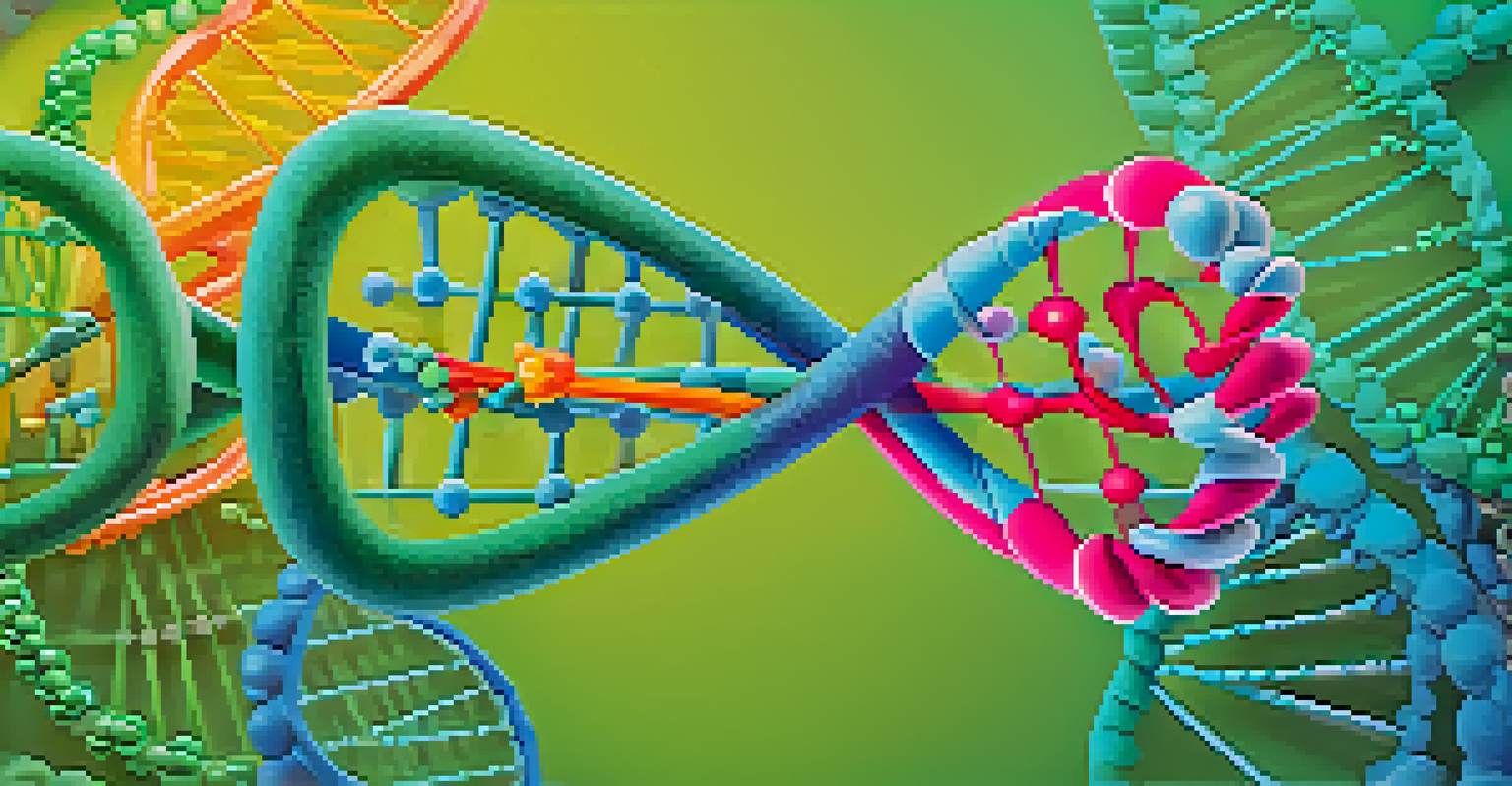CRISPR Technology: Revolutionizing Plant Genetic Engineering

Understanding CRISPR: The Basics of Genetic Editing
CRISPR, which stands for Clustered Regularly Interspaced Short Palindromic Repeats, is a groundbreaking tool for genetic editing. It allows scientists to make precise changes to an organism's DNA, which can lead to significant advancements in agriculture. By targeting specific genes, CRISPR can enhance desirable traits in plants, such as drought resistance or nutritional value.
Genetic engineering is not just about creating new life forms. It is about enhancing the life we already have.
Imagine CRISPR as a pair of molecular scissors that can cut DNA at a specific location. This ability to edit genes with such accuracy opens up a world of possibilities for plant scientists. Instead of relying on traditional breeding methods that can take years, CRISPR offers a faster and more efficient approach to developing improved crop varieties.
As we explore the implications of CRISPR in plant genetic engineering, it's essential to recognize its potential to address global challenges. With the increasing demand for food due to a growing population, CRISPR can help create crops that are not only more productive but also more resilient to climate change.
The Role of CRISPR in Enhancing Crop Resilience
One of the most exciting applications of CRISPR technology is its ability to make crops more resilient to environmental stressors. For instance, scientists can edit genes to help plants withstand drought conditions, which is becoming increasingly important as climate change affects weather patterns. By enabling crops to use water more efficiently, CRISPR could play a vital role in ensuring food security.

Take the example of wheat, a staple food for millions around the world. Researchers have successfully used CRISPR to develop wheat varieties that can survive in arid regions. This means that farmers can grow crops in areas previously deemed unsuitable, ultimately increasing food production and reducing reliance on irrigation.
CRISPR Enhances Crop Resilience
CRISPR technology allows for the development of crops that can withstand environmental stresses like drought, ultimately boosting food security.
Moreover, enhancing resilience through CRISPR isn't just about surviving harsh conditions; it also involves improving pest and disease resistance. By modifying specific genes, scientists can create plants that are less vulnerable to pests, reducing the need for chemical pesticides and promoting more sustainable farming practices.
Boosting Nutritional Content with CRISPR
CRISPR technology also holds tremendous potential for enhancing the nutritional content of crops. With global malnutrition affecting millions, scientists are exploring ways to fortify staple foods with essential vitamins and minerals. For instance, researchers have used CRISPR to increase the levels of beta-carotene in rice, turning it into a source of Vitamin A—a crucial nutrient for eye health.
The future of food is not just about feeding the world, but about feeding it sustainably and equitably.
This concept, often referred to as 'biofortification,' aims to tackle deficiencies in diets that lack diversity. By editing crops to boost their nutritional profiles, CRISPR can play a significant role in improving public health, especially in regions where access to a variety of foods is limited.
Furthermore, the ability to enhance nutritional content is not restricted to just one crop. Imagine a future where various fruits and vegetables are engineered to contain higher levels of antioxidants or minerals, leading to healthier diets and improved quality of life for many.
CRISPR and Sustainable Agriculture Practices
Sustainability is a buzzword in agriculture today, and CRISPR technology can contribute significantly to this movement. By developing crops that require fewer resources such as water, fertilizers, and pesticides, CRISPR can help farmers adopt more sustainable practices. This not only preserves the environment but also reduces farming costs.
For example, CRISPR-edited crops that can thrive on less nitrogen could help minimize the environmental impact of fertilizers. This is particularly important, as excess fertilizer runoff can lead to water pollution and ecosystem damage. By creating crops that are more efficient in nutrient use, CRISPR paves the way for a greener future in agriculture.
Improving Nutrition with CRISPR
By using CRISPR for biofortification, scientists can enhance the nutritional content of staple crops, helping to combat global malnutrition.
Additionally, the reduction of chemical inputs through CRISPR can lead to healthier ecosystems. When farmers use fewer pesticides, it can result in a more balanced ecosystem, supporting biodiversity while still achieving high crop yields.
Potential Risks and Ethical Considerations of CRISPR
While CRISPR technology offers exciting possibilities, it's essential to acknowledge the potential risks and ethical considerations involved. One concern is the unintended consequences of editing genes, which could lead to unforeseen effects on plant health and the environment. This is why rigorous testing and regulation of CRISPR-edited crops are crucial.
Moreover, the ethical implications of genetic engineering extend beyond the science itself. Questions about ownership, access to technology, and the impact on small farmers and biodiversity must be addressed. Ensuring that CRISPR technology is used responsibly requires dialogue among scientists, policymakers, and the public.
Ultimately, navigating these challenges is vital to harnessing the benefits of CRISPR in plant genetic engineering. By fostering a transparent and inclusive discussion, we can work towards solutions that prioritize safety, equity, and sustainability.
CRISPR's Impact on Global Food Security
As the world faces the pressing issue of food security, CRISPR technology emerges as a promising ally. With the population projected to reach nearly 10 billion by 2050, the demand for food will continue to rise. CRISPR can help meet this demand by increasing crop yields and improving the quality of food produced.
For instance, CRISPR has the potential to create crops that can grow in less than ideal conditions, such as poor soil or extreme weather. By making agriculture more efficient and productive, CRISPR could play a significant role in ensuring that everyone has access to sufficient and nutritious food.
Sustainable Farming Practices
CRISPR contributes to sustainable agriculture by creating crops that require fewer resources, minimizing environmental impact and promoting biodiversity.
Additionally, the ability to rapidly develop new crop varieties means that farmers can adapt to changing market demands and environmental challenges more quickly. This adaptability is crucial in a world where climate change is reshaping agricultural landscapes.
The Future of CRISPR in Plant Genetic Engineering
Looking ahead, the future of CRISPR in plant genetic engineering is bright and full of potential. As research continues to advance, we can expect to see even more innovative applications that tackle pressing agricultural challenges. From climate resilience to enhanced nutrition, the possibilities are nearly limitless.
Moreover, as public understanding and acceptance of genetic editing grow, we may witness a shift in agricultural practices on a global scale. Farmers and consumers alike are becoming more informed about the benefits of CRISPR, paving the way for wider adoption and integration into food systems.

Ultimately, the journey of CRISPR technology is just beginning. With continued research, collaboration, and responsible implementation, CRISPR has the power to revolutionize plant genetic engineering and contribute to a more sustainable and food-secure future.